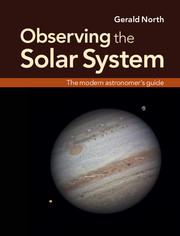Book contents
- Frontmatter
- Contents
- Preface
- Acknowledgements
- Chapter 1 Earth and sky
- Chapter 2 Moon and planet observer's hardware
- Chapter 3 The Solar System framed
- Chapter 4 Stacking up the Solar System
- Chapter 5 Our Moon
- Chapter 6 Mercury and Venus
- Chapter 7 Mars
- Chapter 8 Jupiter
- Chapter 9 Saturn, Uranus and Neptune
- Chapter 10 Small worlds
- Chapter 11 Comets
- Chapter 12 Our daytime star
- Appendix 1 Telescope collimation
- Appendix 2 Field-testing a telescope's optics
- Appendix 3 Polar alignment
- Index
Chapter 9 - Saturn, Uranus and Neptune
Published online by Cambridge University Press: 05 November 2012
- Frontmatter
- Contents
- Preface
- Acknowledgements
- Chapter 1 Earth and sky
- Chapter 2 Moon and planet observer's hardware
- Chapter 3 The Solar System framed
- Chapter 4 Stacking up the Solar System
- Chapter 5 Our Moon
- Chapter 6 Mercury and Venus
- Chapter 7 Mars
- Chapter 8 Jupiter
- Chapter 9 Saturn, Uranus and Neptune
- Chapter 10 Small worlds
- Chapter 11 Comets
- Chapter 12 Our daytime star
- Appendix 1 Telescope collimation
- Appendix 2 Field-testing a telescope's optics
- Appendix 3 Polar alignment
- Index
Summary
At Jupiter's orbit the light from our Sun is so spread out that it illuminates with a mere one twenty-seventh of its strength at the orbit of our Earth. Of course, even that is nowhere near the outer limits of our Solar System. There are still three mighty worlds and a vast number of very much smaller bodies orbiting much further out where the sunlight is even dimmer. The next major planet is Saturn, where sunlight shines a mere one ninetieth of the brightness we are used to. Beyond that is Uranus and beyond that is Neptune. From these worlds our Sun has very roughly one four hundredth and one nine hundredth of its intensity, respectively. Their great distances also mean that the time light takes to cross from the planet to us is significant, despite the fact that a pulse of light travels three hundred thousand kilometres every second. Whenever we look at Saturn we are actually seeing it as it used to be just over an hour before. Make that two and a half hours in the case of Uranus and fully four hours in the case of Neptune! It is little wonder that these twilit worlds appear wonderfully unearthly and ethereal through our telescopes. In this chapter we will consider each major planet in turn along with what observations we can usefully make of them.
SATURN IN THE SKY AND THROUGH THE TELESCOPE
One starry winter's evening early in 1971 I was in the garden with the 3-inch (76 mm) reflector my parents had recently bought for me. On a few previous nights I had already had my first close-up views of the Moon's magnificent vistas through it. On this night I remember looking up and seeing an intriguing little group of blue stars twinkling in the sky. Only later did I learn that that group was the Pleiades star cluster. Not far from the cluster was something that immediately struck me as very different – a prominent star that didn't twinkle like the rest. It had a leaden yellow hue that looked totally unlike the colours of any of the other stars in the sky. I wondered if it could be a planet – I very much hoped so as it would be my first sighting of one through my new ‘proper’ astronomical telescope.
- Type
- Chapter
- Information
- Observing the Solar SystemThe Modern Astronomer's Guide, pp. 269 - 312Publisher: Cambridge University PressPrint publication year: 2012

